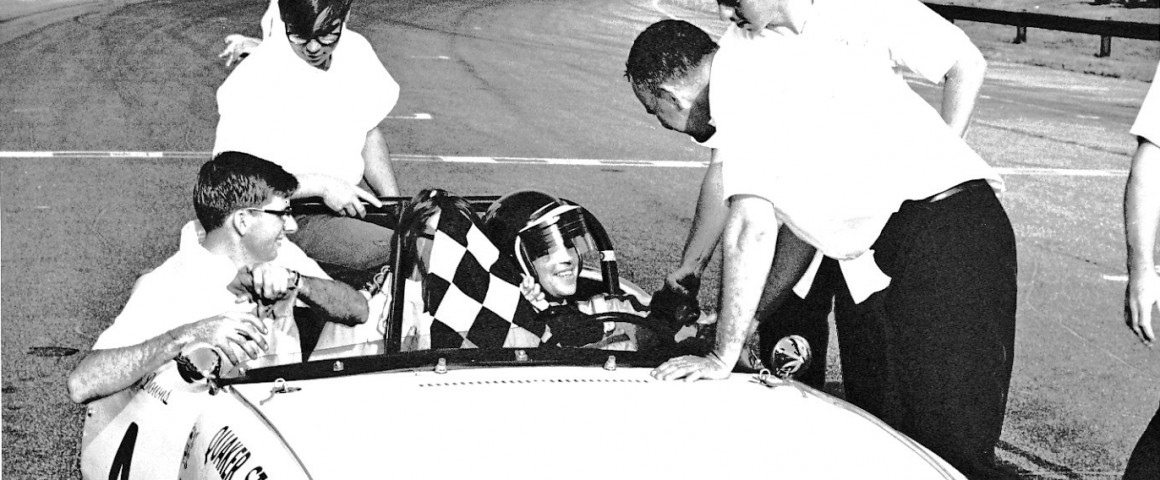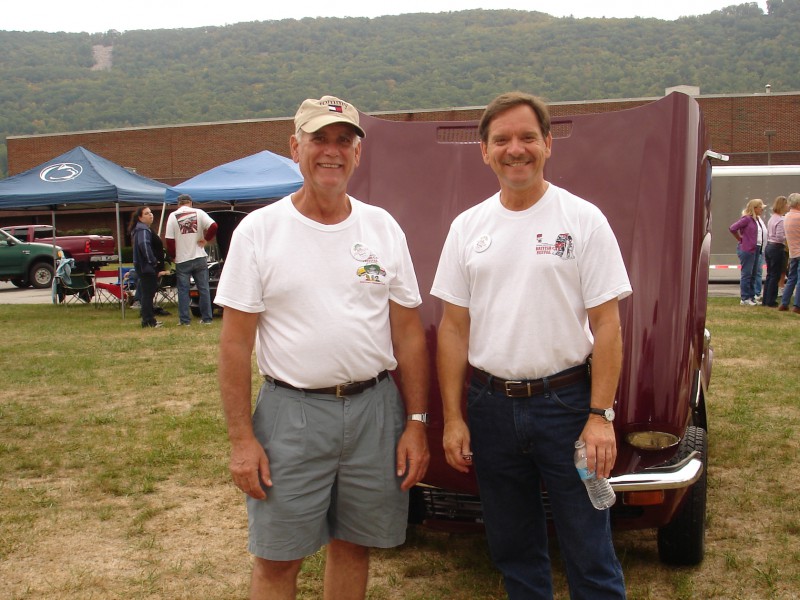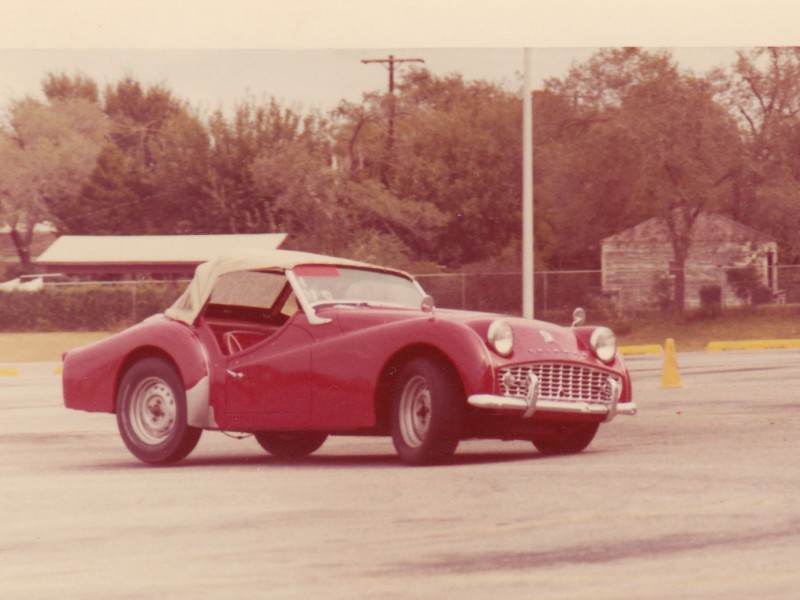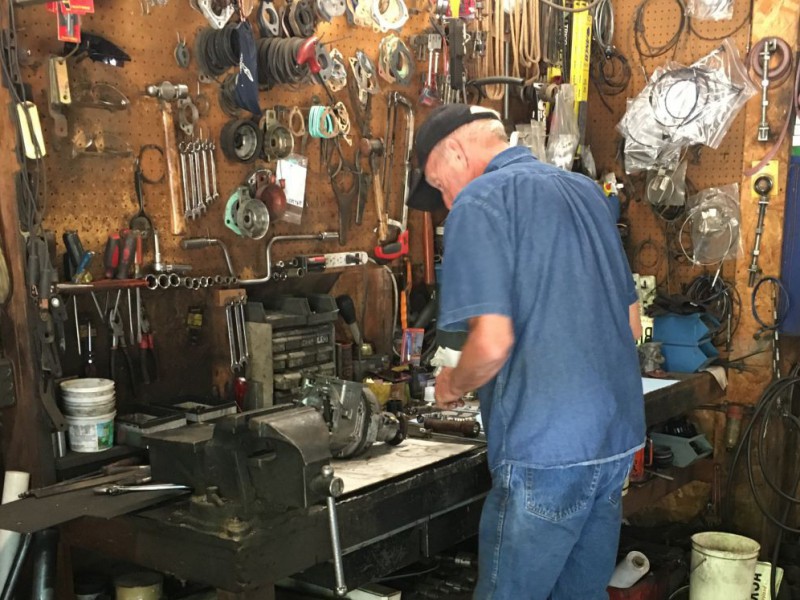By Mike Downs
In my early teens I got a job at a foreign car parts store in Falls Church, Virginia. A couple years later I became a mechanic in a foreign car garage that was once a horse stable and still had a dirt floor. The attic above the tin plate ceiling was a source of amazement for me as it held old Ford Model T parts and stacks of yellowed receipts. I enjoyed reading what the jobs entailed and the unbelievably low prices in those days.
I was the shop’s sole mechanic, mainly self-taught by reading all the manuals I could get my hands on. Frank Baptista, the owner of the garage, booked the work. Frank was a champion sports car racer who also helped me learn mechanics. He had his Elva Mk VI in the shop, and I dreamed of racing from the first time I sat in it. The dream gained steam as local race-cars found their way into the shop, mostly Triumphs and Sprites. Sports Car Graphic and Road & Track at that time were filled with tech articles on how to modify engines, transmissions and suspension systems. Bench racing with the drivers and crews also gave me useful insight.
After saving some money I bought a used Austin-Healey Sprite Mk II and had a blast with it. It just needed more power. The local bone yard had exactly what I wanted—a Buick 215 cubic inch aluminum V8 and a TR3 rear axle. After months of work, it was the fastest car around.

Out East, the legal age to race was twenty-one, and for me time dragged by until I could go to driver’s school. I made a deal with a Triumph TR4 racer to work on his car for free if I could use the car for the two mandatory driver’s schools. I did one school at Marlboro and the other at Watkins Glen. I had a great time and, at long last, a racing license! I sold my Sprite to car buyers so that I can buy an old Lotus 23 and got busy getting it race-ready. Along the way, I met Group 44’s Bob Tullius and began traveling around the country on race weekends for him as a mechanic. During the week I headed back to the dirt floor garage.
One of Tullius’s drivers left and Bob asked me to drive for him. I was there in a flash. I’ll never forget walking into the Group 44 shop on Gordon Road and seeing my name on their G production Spitfire. A new education began under the sharp eye of Brian Fuerstenau, the head engineer, a brilliant, skillful man. He and I worked together from early morning to late at night every day during the season. I shouldn’t call it work; it was a grand adventure for me. This time of my life felt like a dream. In my first year I won the region, and the following year Bob let me drive the new GT6 Plus. It was a handful but strong enough to win the national championship held in Daytona, Florida.
CALIFORNIA DREAMING
I left for the west coast on a handshake agreement and what I thought would be a step to the big leagues. In those days the word was if you wanted to be in big time racing you had to have rear-engine experience. But after winning some Formula Ford races, the agreement dissolved.
I loved the sunshine and wanted to experience California, so I found work at a couple local shops. It was here where I met some very talented fabricators. I watched them do their magic and learned TIG and MIG welding by trial and error. I picked up an MGA with no top and enjoyed my first warm winter.
Always on the look out for opportunities in racing, I took a job back East to prepare a 2.4 litre Porsche for the Daytona 24-hour race. IMSA tech sent a memo that the new Porsches would not be eligible to run the 24-hour if the cars were not equipped with fuel cells. I scrambled to get one made, and Goodyear finally agreed to build one to my design.
When I got the car to Daytona, the tech workers congratulated me on the fuel cell, then told me they had granted the factory Porsches special dispensation: their plastic tank would be legal for the 24-hour. It was a hard fought race that I enjoyed, sharing the driving with Bruce Jennings and George Stone. We beat the factory teams and won the class.

I came back to California to open my own shop, Downs Engineering, in Los Angeles. The business of building race-cars and street specials is part of the LA culture. A memorable project was a McLaren M8 Can Am car that I fashioned into a street legal car. I also did some jobs for a car shop that employed a few of the great ex-Indy Car metal-crafters. These men made custom car bodies from aluminum and steel, and I studied their methods intently. The lure of LA diminished with the growing crowds, and so I headed north for the calm of Monterey.

The aptly named Sand City became the location for my shop. MG T series cars were abundant there, and there was plenty of restoration work. The people at Moss Motors had all the parts I needed to do first class work. I also had the good fortune to meet my wife, Kathy, while working on her vintage racing MGTF. We moved from the cold, foggy sand dunes to Sears Point Raceway in Sonoma.
The owner of the racetrack was in the process of building new shops on the grounds and talked us into being his first tenants. Kathy raced her TF and I raced a Formula Atlantic Ralt, and then a Pontiac in Trans Am. I bought a used Triumph TR8 from Joe Huffaker to enjoy the Northern California back roads. On the side I was a stunt driver for the film industry and built cars for TV commercials.
My contact with producers and directors resulted in restoring Formula One cars for them. An Arrows F1 needed a new tub, suspension, and bodywork that I enjoyed fabricating. When completed, the new owner was as delighted as I was with the finished product. More vintage formula projects came my way. For a few years that was the thing to do for the top film guys until they moved on to the next fad.
After our five-year lease was up at the racetrack, we moved to the outskirts of Sonoma where Kathy increased the size her Fox Fabrique embroidery business and I got more room to work. We have been in our current building for over twenty-five years now!
I reluctantly sold the TR8 to help fund the creation of my own Sports Racing cars. The years spent watching the masters work metal paid off. I hand built original aluminum bodies, these then served as bucks to make the fiberglass bodies of the race cars. The idea was to make a low-cost car that could compete with the Radicals and Lolas dominating the class. The maintenance of my cars was both easy and cheap—they ran with Hayabusa racing engines—which made them ideal for the cost-conscious. We sold quite a few, and they were a ton of fun to race. I won the regional championship.
LOOKING BACK, MOVING FORWARD
I’m sure it goes without saying that a solid education is essential for any automotive industry job today. I had the good fortune to learn while working with some of the best in the business. Getting thrown in the deep end by necessity accelerated my education. Unfortunately my engineering education in school was all too brief as I was often traveling to races. My engineering instructor’s most valuable words for me were: “Simplicity is the essence of design. A complicated design is more prone to failure.”
At the different stages of my career, I appreciated the professionals that took time to show me the right way to do a job, or to point out a better approach. I will say that my career is a very rewarding one. Studying engineering and race-car engineering books through the years has also been a grand source of learning to keep pace with a rapidly changing landscape.
A few years ago I started writing mystery and adventure novels based on racing in the 1920s, ’30s and ’40s. This period of time I find very inspirational; a great deal of automotive innovation took place by a seat-of-the-pants technique. Drivers and teams had few rules, as compared to today’s racing, to constrict their ingenuity.

The Miller cars of the 1920s and ’30s were extraordinary examples of mechanical beauty and construction. Doing research for my novels rewarded me with a grand appreciation for the labor and ingenuity that went into Miller’s creations. The inventions of many early automotive components are fine stories in themselves. The commitment of the innovators to get it right at the cost of great sacrifice is amazing. These are the some of the elements I weave into my novels. I am on my eighth novel, a World War Two mystery.
There are many things that you need to think about just to get started with invention journey, and there are professionals who can help you with this. Trying to find a New Invention Service Provider can help assist you with getting a legal expert to sort out patent protection.
Kas and Peggy Kastner are two of the beta readers and I am very fortunate to be able to call them friends. I have known Kas since my Group 44 days when he was the big boss for Triumph Racing in America. Now that I’m thinking about it, I do miss that TR8. I hope you enjoy your sports car adventures!








'Of Sprites and Triumphs – A Life of Cars' has 1 comment
August 27, 2024 @ 12:55 pm Richard Padgett
A most interesting read about an even more interesting life. What grabbed me, however, was the mention in the third paragraph of an Austin-Healy Sprite with a Buick 215c.i. V8. I recall seeing such a car in 1965 at Pat Goodman’s (the late founder and owner of Summit Point Raceway in West VA) shop on Gordon St. in Falls Church, near the Group 44 garage. I seem to recall that there was something unusual about the transmission? Although you don’t mention the year, the Falls Church location and your association with Bob Tullius leads me to suspect that it was your car. I remember the date because that was the year that I bought a used 1961 Triumph Herald convertible that spent much of 1965 in Pat’s shop, until I realized that my meager salary could as easily pay for a new MGB as repairs to the Triumph were costing me. (the MG was Pat’s recommendation)
In any case, your article reminded me of my youth; thank you.